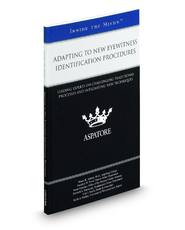In
Adapting to New Eyewitness Identification Procedures, leading experts discuss challenging traditional processes and integrating new techniques for eyewitness interviewing and criminal identification practices. Featuring experts in eyewitness identification procedures from across the country, including law enforcement officials, attorneys, and academics, this product guides readers through the flaws of the current system and recent reforms, such as identifying suspects through sequential display methods (as opposed to using simultaneous display) to prevent false identifications. Emphasizing the importance of staying on top of these developments, the authors describe the scientific research behind how witnesses recall information and how this information has driven changes in lineup procedures and witness questioning strategies.
Chapter titles include:
- Improving the Accuracy of Eyewitness Evidence
- Understanding and Utilizing New Lineup Procedures
- Preventing Misidentification by Utilizing New Techniques
- The Courts, Attorneys, Eyewitnesses, and the Need for Change
- Reforming Eyewitness Identification Procedures to Enhance Reliability and Protect the Innocent

